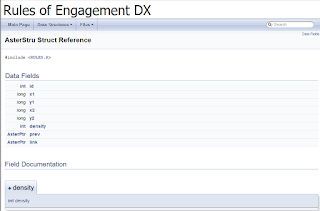 |
| The Button Pad |
 |
| Star Raiders |
In the very early
80s when I was around eight or nine, my family had come across the
pinnacle of home video game entertainment. It was an Atari 2600, and
it had with it the staple of your classic games. Of these, the one
that really stood out for me was a game called “Star Raiders”.
What made it so engaging was how revolutionary the interface was.
Here your TV became the forward view of a star fighter. You could see
stars whiz past your ship in 3D as you took the joystick and jockeyed
for position to fire upon hapless aliens. What made the game truly
amazing was a special button pad that came with it. Here you could
open up a galaxy map, set your course, and engage hyperdrive to other
sectors. While barreling at light speed to you destination, you could
go back to you forward view screen and watch even more stars fly past
you until you arrived. One dropping out of hyperdrive you were often
greeted with an alarm klaxon and more enemy alien ships to destroy.
I remember taking
all the couch cushions, pillows, and blankets I had access to and
constructing an elaborate pillow-ship in front of the TV. I draped
the blankets around the television, blocking out the outside world.
Once ensconced within my fluffy cockpit, my imagination went wild. To
me I was in space. My spaceship held the battle lines until it was
ultimately destroyed. Not by the alien invaders, but by my little
sister who was mad I was “hogging the TV” and wanted to watch
“Land of the Lost”
I’ve been told I’m
not the first person to do this.
 |
| Rules of Engagement |
Fast forward about
10 years and now it’s the early 90s. To set the stage Star Trek:
The Next Generation was in full swing and I came across a game called
“Rules of Engagement”. Once again the box art showed you could
pilot a spaceship, but this time using a snazzy touch screen
interface much like the starships of Next Gen. Keep in mind this was
around 1992 and touch screens being commonplace was more then 20
years off. The “touch” interface in this game was a mouse pointer
that looked like a hand with fingers splayed open. (Keep in mind, the
hand/index finger mouse pointer was not really standardized at this
time yet.)
“Rules” was a
deeply engrossing game for me. I would play on my 8088 PC and from
time to time I would pretend my CRT was an actual touch screen;
tapping the screen with my left hand while my right hand moved the
mouse and did the actual articulation. I felt like I was in control
of a starship fleet, issuing commands on my screen and battling 16
color alien races.
Jumping time once
again, let’s skip to a few months ago. Somehow Rules of Engagement
popped in my head I decided to see whatever happened to the company
that made the game. As it would seem they are still around. The
company appeared to have moved on to making communications software,
and the old games they used was nowhere on their website. On a whim I
decided to send an email to the generic looking sales@ email address
and asked of the game even existed anymore or if anyone at the
company even heard of it.
I was thinking to
myself, “If they still had the source code, couldn’t it be pretty
cool to port this game to a device with touch screen, or at least get
it into a state where it was playable again?” You see the game
itself has not fared well with time. It’s a 16-bit DOS game that
will simply not execute under 64-bit windows. Graphics chips nowadays
are beginning to drop lots of the old legacy video modes like the
2-bit CGA and 4-bit EGA. Heck, I’m beginning to see 8-bit VGA modes
being depreciated too. Another issue is that it runs very poorly in
both virtual and emulated environments. If I was a betting person,
it’s most likely due to the frame rate limiter. Hedging all my bets
there is probably an interrupt that’s firing that’s a bit
time-sensitive and causing the system to hang on the opening credits.
This next bit of the
store is going to be a bit vague as it deals with company email
correspondence that I’m not sure I’m allowed to divulge. The
upshot was I able to contact one of the original developers of ROE.
Though what I can only guess as my winning charm, I was able to
procure the original C source code and project files for the game. I
pitched that the idea of porting this game to modern architectures
and giving it a bit of a face lift is a good idea, and they agreed.
This blog is going
to be my adventure as I port a professionally developed and sold
video game from 1991 to something platform independent. Trust me,
having looked behind the curtain a little, it’s time capsule of
glorious treasure. Old programming philosophies came flooding back at
me as I did my assessment of the code. This is going to be a fun ride
I think..
Thanks again Tom,
for the opportunity to do this.
 This took me much longer than it should have. I wanted to get the graphic fade in/fade out functions done.Because I'm not using color palettes I thought I would be cheeky and try my own implementation of fading in and out the graphics. Nermal has the following API functions.
This took me much longer than it should have. I wanted to get the graphic fade in/fade out functions done.Because I'm not using color palettes I thought I would be cheeky and try my own implementation of fading in and out the graphics. Nermal has the following API functions. 






